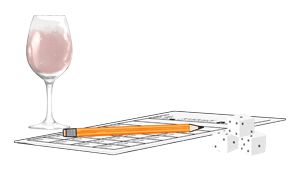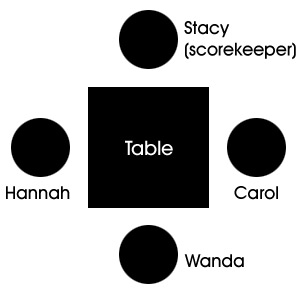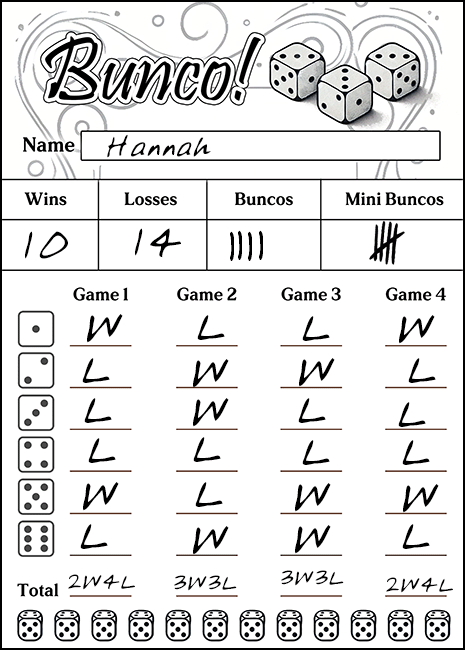Bunco Rules

If you're looking for complete and clearly explained rules for Bunco then you've come to the right place! Never played Bunco before? Start with our "What is Bunco" section below where we provide a simple overview of how the game works.
- What is Bunco?
- Bunco supplies and components
- Preparing for a Bunco game
- Rolling and scoring in Bunco
- How to play Bunco:
- Beginning the game
- Example of play
- Individual player scoring
- Additional rounds
- Finalizing your score
- Tiebreakers during a round
- Optional rule: Traveling
- Optional rule: Prize categories
After you're done reading the rules here, head over to our Bunco FAQs page for more information on starting a Bunco group and hosting parties!
ADVERTISEMENT
What is Bunco?

If you're brand new to the game of Bunco, head over to our Bunco for Beginners page for a short rundown of what Bunco is all about. Or you're welcome to stay here and get a full overview of the game.
Bunco is a fun and social dice game, typically played with 12 players divided into three tables of four players each. However, you can play Bunco with almost any number of players. (If your player count isn’t divisible by 4, check out our Bunco FAQs for tips on playing with "ghost" players.)
Here’s a quick guide on how to play Bunco.
Basics of Bunco:
- Game Structure: A session of Bunco typically consists of four games, with six rounds in each game, but can range anywhere from two to six games.
- Setup: Players sit at multiple tables, with four players at each table. One table is designated as the head table.
- Gameplay: Players at each table take turns rolling three dice to earn points, with all tables playing simultaneously.
- Teams: Players will switch seats and tables during the game. For each round, players sitting opposite each other are on the same team.
- Round Signals: A player at the head table rings a bell to start and end each round.
- Gameplay and Scoring: During each round, players try to roll the same number on the dice as the current round number (e.g., rolling 3s in round 3, or 4s in round 4). One point is awarded for each die that matches the round number, but special scoring occurs if all three dice show the same number. If the three dice match the number of the round being played, it’s called a Bunco and the player earns 21 points. If a player rolls three of a number that doesn’t match the round number, the player earns 5 points instead.
- Ending a Round: When a team at the head table reaches 21 points, the round ends, and the bell is rung to signal this.
- Changing Partners and Tables: After each round, players change seats and/or tables.
- Winning: At the end of the session there are often multiple winners, with prizes for most Buncos, wins, losses, etc.
But don't let this dry summary of the game give you the wrong impression. Bunco games are known for being lively and loud, filled with socializing, dice rolling, friendly competition, and lots of celebrating! It's a great way to bring people together for fun and friendship.
ADVERTISEMENT
Bunco Supplies and Components
Bunco requires the following components:
- Three dice for every table
- One Bunco score sheet for every player
- One Bunco table tally for every table
- A bell (or other noisemaker) for the head table
- One pencil for every player
Optional components include:
- Table signs that specify which table is which. Sometimes these signs indicate which tables the winners and losers of each round should move to.
- A plush dice or other soft object that can be used as a "Traveler"
You can even purchase everything you need in a Bunco game kit!
You can find more information about the game and about starting a Bunco group over on our Bunco Questions page.
It's common practice to turn the game into a party, with food, drinks, and decorations. Wine or other types of alcohol are a popular addition to any Bunco party, as is themed décor and food. For example, you might want to create a Bunco party with an 80s theme, or Mardi Gras, or Octoberfest. Even basic Bunco parties can have a dice or casino theme! Need some ideas? We've got 15 fabulously fun Bunco party ideas right here, or 5 Bunco party themes to inspire you, complete with suggestions for decor, food, prizes, and even dice!
Shop the dice superstore at DiceGameDepot.com
- Over a thousand varieties of dice styles and colors
- Bunco score cards and supplies
- Buy dice singles or sets
- Discounts on bulk quantities
- Each order carefully inspected and packed with care
Browse: 6-sided dice | Dice sets | Polyhedral dice | Dice in bulk | Game supplies
Preparing for a Bunco Game
Preparing and setting up for a game of Bunco easy, and getting everything ready ahead of time ensures a fun and organized game.
First, number the tables as #1, #2, #3, and so on. Alternatively, tables can be named: High Table, Middle Table, and Low Table. This helps players know where to move to if they switch tables between rounds.
Put the bell on the High Table (table #1, also sometimes called the Head Table). This bell will be used to signal the beginning and end of each round.
At each table, place the following items:
- three dice
- A Bunco table tally
- A Bunco score sheet for each player
- A pencil for each player
Or get all of the above in a handy boxed Bunco game!
Place four players at each table. Players who sit opposite of each other are partners for that round. This pairing will change as players switch tables and seats between rounds, keeping the game dynamic and engaging.
Designate one player at each table as the scorekeeper. The scorekeeper is responsible for using the table tally to track each team's points during the game.
With these preparations, you’re all set to start a lively game of Bunco, where players can enjoy the friendly competition and camaraderie that makes this game so popular.
Rolling and Scoring in Bunco
In Bunco, players score points when any of the dice they roll match the number of the current round. Each matching number rolled scores 1 point. For instance, if a player rolls two 2s in round 2, they receive two points and roll again.
The numbers on the dice aren’t added together, nor do they indicate the point value directly. A 1 rolled in round 1 is worth 1 point, a 3 rolled in round 3 is worth 1 point, and a 6 rolled in round 6 is also worth 1 point.
However, special scoring occurs if all three dice show the same number:
- If the three dice match the number of the round being played, it’s called a Bunco, and the player earns 21 points. The player must call out "Bunco!" to receive these points. For example, if a player rolls three 4s in round 4, they would call out "Bunco!" and earn 21 points.
- If a player rolls three of a number that doesn’t match the round number (for example, rolling three 6s in round 4), the player earns 5 points instead. This is known as a "mini Bunco" or a "baby Bunco."
ADVERTISEMENT
How to Play Bunco: Beginning the Game
Each round begins when the head table rings the bell. When that happens, the scorekeeper at each table picks up the three dice and begins rolling them.
Every time the dice are rolled, each die is read separately (they aren't added together).
- In round 1, each 1 rolled is worth 1 point.
- In round 2, each 2 rolled is worth 1 point.
- In round 3, each 3 rolled is worth 1 point.
- In round 4, each 4 rolled is worth 1 point.
- In round 5, each 5 rolled is worth 1 point.
- In round 6, each 6 rolled is worth 1 point.
- Rolling three-of-a-kind of the same number of the round you're on is a Bunco. The player must call out "Bunco!" to receive 21 points, and then must keep rolling (unless the player is sitting at the head table in which case she rings the bell to signal the end of that round).
- Rolling three-of-a-kind of any number other than the round you're on is worth five points, also known as a mini Bunco.
For example, rolling three 5's in Round 3 is a mini Bunco and is worth five points.
Each player continues rolling until they score no points. The scorekeeper then records the points the player earned onto the table tally as the temporary team score. Then the dice are passed to the player on the left.
The round ends when a team at the head table accumulates at least 21 points. A player at the head table who earned the 21 or more points rings the bell to signal the end of the round.
However, all players who are taking their turn when the round ends -- including the player who rang the bell -- continue rolling until one of their rolls earns them no points, even though the round is officially over. This means that a player may possibly earn several points or even roll one or more Buncos after the bell has been rung!
It's possible for a team to win a round without rolling any Buncos.
How to Play Bunco: Example of Play
A game of Bunco has just begun. At the head table, the bell is rung to signify the start of the round.
In this first round, each 1 rolled by any player is worth 1 point.

At every table, the scorekeepers pick up their dice and begin rolling. At the head table, Stacy, who is the scorekeeper for that table, rolls two 1's and one 3:
![]()
![]()
![]()
Since two 1's were rolled, she earns 2 points and continues rolling.
![]()
![]()
![]()
This time she rolled 4, 2, and 1. She earns one more point for rolling the 1 and then she rolls again.
![]()
![]()
![]()
This time she rolls two 6's and a 2. She didn't roll any 1's so she didn't earn any points. Stacy ends her turn and passes the dice clockwise to Carol, the next player.
Stacy is the scorekeeper, and since she earned 3 points during her turn, she puts a 3 in the "Us" column on her table tally.
Carol rolls the dice. She rolls a 2, a 1, and a 6:
![]()
![]()
![]()
A single 1 is rolled so Carol earns 1 point and rolls again.
![]()
![]()
![]()
She rolls 5, 4, and 1. Again she rolls a single 1 so she earns 1 more point and continues rolling.
![]()
![]()
![]()
This time she rolls a 3, 4, and 5. Since Carol didn't roll any 1's this time, she earns no points and she passes the dice clockwise to the next player, Wanda.
Stacy, the scorekeeper, writes down Carol's score. Carol is not Stacy's partner (they are not sitting across from each other) so Stacy puts a 2 in the "Them" column of her table tally.
Wanda rolls the dice.
![]()
![]()
![]()
She rolls three 3's which is 3-of-a-kind! However, since it is currently round 1 and not round 3, it's a "mini Bunco" but not a Bunco. Wanda earns 5 points instead and continues rolling.
![]()
![]()
![]()
She rolls a 4, 5, and 2. Wanda rolls no 1's so she earns no further points and she passes the dice to the player on her left, Hannah.
Wanda is Stacy's partner, so Stacy writes down a 5 in the "Us" column of her table tally.
Hannah rolls the dice. She rolls three 1's:
![]()
![]()
![]()
A Bunco! She calls out "Bunco!" and, since she is sitting at the head table and has earned 21 points, she rings the bell to signal that the round is over.
However, players who are still taking their turn may continue rolling as long as they continue to earn points. (This includes Hannah, even though she is the one who rang the bell.) Players can continue to earn points and roll Buncos until they roll no points, then their turn is over.
Since she just earned points and still has a chance of earning more, Hannah rolls again.
![]()
![]()
![]()
She rolls a 4 and two 3's so she earns no further points, her turn is over, and the round ends.
At the end of the first round, Stacy's table tally looks like this:

Stacy and Wanda earned a total of 8 points, and Carol and Hannah earned 23 points and win this round.
How to Play Bunco: Team Scoring
At the end of a round, the scorekeeper adds up all the points earned during that round by the two teams at the table. The team with the highest total wins the round.
How to Play Bunco: Individual Player Scoring
Each player should have their own individual score card and keep track of their rounds on it.
- When a player wins a round, they should write a "W" on the line for that round.
- When a player loses a round, they should write an "L" on the line for that round.
- When a player rolls a Bunco, they should place a tally mark for each occurrence in the space marked "Buncos"
(NOTE: Only the player who rolled the Bunco will write down that they rolled a Bunco in that round. The player's partner will not!)
Some score cards have a space for tracking mini Buncos as well.
For example, in the game described above, each player on the winning team -- Carol and Hannah -- will record a "W" on the first " ![]() ________ " line on their scorecards. Since Hannah rolled a Bunco, she will also place a tally mark in the line provided.
________ " line on their scorecards. Since Hannah rolled a Bunco, she will also place a tally mark in the line provided.
Hannah's Bunco score card then looks like this:

And at the end of the night, Hannah's score card may look something like this:

For score cards that include a "Total" line for each game, players may choose to not keep running tally marks of wins and losses. Instead, they can simply write down the total number of wins and losses in each game and then add those up at the end of the night to determine their final win and loss totals which they can then write in the appropriate spaces on the score card.
For example, Hannah's score card may also look something like this at the end of the night:

How to Play Bunco: Additional Rounds
At the beginning of each new round, all players should change seats and/or partners. If playing with three tables, the seating arrangement would change as follows:
- The winning team at the head table (table #1) stays at the head table, but one of the players should move over a chair so they will have a different partner for the next round.
- The losing team from the head table should move to the middle table (table #2).
- The winning team from table #2 moves to the head table.
- The winning team from table #3 (sometimes humorously called the "Losing" table) moves to table #2.
- The losing team from table #2 goes to table #3.
- The losing team at table #3 stays at the table but one player should moves over a chair so they will have a different partner for the next round.
At the beginning of each round, someone at each table must volunteer to keep score.
Rounds 2 through 6 are played exactly as round 1 except that in each round, points are awarded for the number of the dice that are the same as the number of that particular round. So for example, in round 2 the object is to roll 2s, and a Bunco will consist of three 2s.
Continue with each round until all the rounds are completed (or you decide to wrap things up).
How to Play Bunco: Finalizing Your Score
When all the rounds are completed, each player should count up all the occurrences of Wins ("W"), and Losses ("L") on their score sheet and then write the totals in the Wins and Losses boxes on their score card.
ADVERTISEMENT
Tiebreakers During a Round
If both teams at a table have a tied score at the end of a round, they participate in a roll-off. Each player is allowed to roll the dice again for one session to accumulate additional points. The scorekeeper begins rolling first. This player will continue to roll and accumulate points as long as they are successfully rolling the number of that round. Each player is given a session to roll and accumulate points for their team to end the tie.
Example: At the end of round 2, a table's teams are tied. Player 1 rolls 1, 1, 2 and accumulates 1 point. Player 1 rolls again but does not roll any 2s. The dice are then passed to players 2, then 3, and then 4, all who receive chances to accumulate points.
If at the end of this session one team is now in the lead, the roll-off ends. The team with the highest score is deemed the winner.
If at the end of this first session the teams are still tied, additional roll-off session (s) are repeated until the tie is broken.
Optional Rule: Traveling
If you choose to add Traveling to your game, a soft fuzzy dice or small bean bag or other tossable object is used.
Traveling occurs whenever a specific set of numbers are rolled. The exact numbers that must be rolled are determined by the hostess or players and announced at the beginning of the game or round. For example, rolling three 2s in ANY round, or three-of-a-kind of any non-Bunco trio (such as three 5s) in ANY round (except round 5).
Then, when the specified trio of numbers are rolled, the player shouts out "TRAVELING!" and the bag or object is tossed to the lucky player. The player holds it until another player rolls Traveling.
The player holding the bag or object at the end of the game or the night wins a prize!
Optional Rule: Prize Categories
The hostess may choose to create award categories and offer prizes to the players. Here are some suggestions:
- Most Buncos
- Most mini Buncos
- Most Wins
- Half Wins and Half Losses (Player with an even split of wins and losses)
- Last Bunco
- Most Losses
- Traveling (Last person holding the traveling item)
Visit our Bunco Questions page for more details on Bunco parties!
Alternative Bunco Rules
The rules of Bunco can be modified or added to in a variety of ways. If you attend a Bunco game in which some of the rules are different than those listed above, that's okay! Just ask and make sure you understand what the rules are before the game begins.
Here is an example of a rule change that you might choose to use in your own Bunco game:
Stop When The Bell Rings
In the rules described above, all players continue rolling after the bell is rung, and their turn doesn't end until they make a roll that scores no points. In this Bunco variant, however, all players stop rolling and end their turns immediately when the bell is rung. If a player is just about to roll or in the process of rolling when the bell rings, they are allowed to finish their turn. (Or alternatively, if the player is getting ready to roll the dice, but the dice haven't yet left their hand, then they should stop and not finish the roll.)
ADVERTISEMENT


